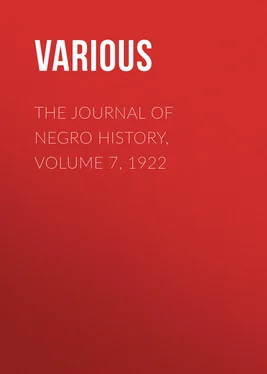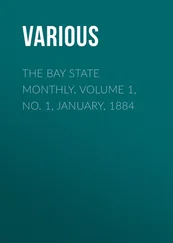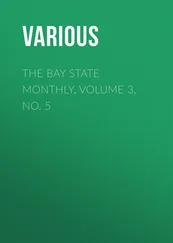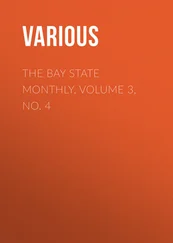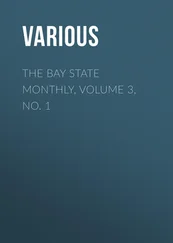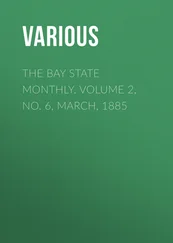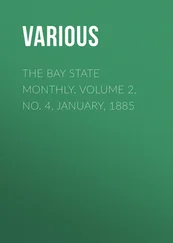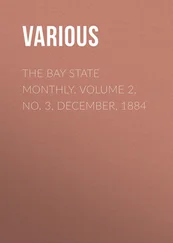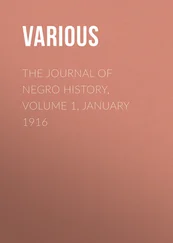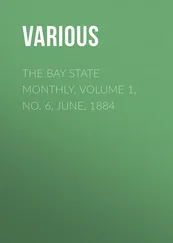Various - The Journal of Negro History, Volume 7, 1922
Здесь есть возможность читать онлайн «Various - The Journal of Negro History, Volume 7, 1922» — ознакомительный отрывок электронной книги совершенно бесплатно, а после прочтения отрывка купить полную версию. В некоторых случаях можно слушать аудио, скачать через торрент в формате fb2 и присутствует краткое содержание. Жанр: foreign_antique, periodic, История, foreign_edu, на английском языке. Описание произведения, (предисловие) а так же отзывы посетителей доступны на портале библиотеки ЛибКат.
- Название:The Journal of Negro History, Volume 7, 1922
- Автор:
- Жанр:
- Год:неизвестен
- ISBN:нет данных
- Рейтинг книги:3 / 5. Голосов: 1
-
Избранное:Добавить в избранное
- Отзывы:
-
Ваша оценка:
- 60
- 1
- 2
- 3
- 4
- 5
The Journal of Negro History, Volume 7, 1922: краткое содержание, описание и аннотация
Предлагаем к чтению аннотацию, описание, краткое содержание или предисловие (зависит от того, что написал сам автор книги «The Journal of Negro History, Volume 7, 1922»). Если вы не нашли необходимую информацию о книге — напишите в комментариях, мы постараемся отыскать её.
The Journal of Negro History, Volume 7, 1922 — читать онлайн ознакомительный отрывок
Ниже представлен текст книги, разбитый по страницам. Система сохранения места последней прочитанной страницы, позволяет с удобством читать онлайн бесплатно книгу «The Journal of Negro History, Volume 7, 1922», без необходимости каждый раз заново искать на чём Вы остановились. Поставьте закладку, и сможете в любой момент перейти на страницу, на которой закончили чтение.
Интервал:
Закладка:
After this meeting of such unusual interest and unexpected success, the West Virginia Teachers' Association reached its purely pedagogic setting. It ceased to be the organization concerned with the general social uplift, of all, and thereafter restricted its program largely to educational matters. This was due not so much to any desire on the part of the teachers to discontinue cooperation with the clergy, but rather to direct attention primarily to the problems of education. Ministers, thereafter, figured less conspicuously in the conventions, except so far as their interests were coincident with those of the teaching body.
There have been twenty-eight sessions of the Association held at Charleston, Huntington, 56Parkersburg, Hinton, St. Albans, Bluefield, Institute, Kimball, and Harper's Ferry. The session which was scheduled for Clarksburg in 1900 was called off because of the outbreak of small-pox just before the time for the session to be convened.
Eleven well-known persons have served as president of the Association. Byrd Prillerman served nine terms, C. W. Boyd one, J. R. Jefferson one, J. W. Scott three, H. H. Railey one, Hamilton Hatter one, R. P. Sims two, E. L. Rann two, J. W. Moss two, A. W. Curtis two, John F. J. Clark two, and H. L. Dickason, the present incumbent, two. Those who have served as secretary are Miss Rhoda E. Weaver, Miss M. Blanche Jeffries, Miss Clara Thomas, Miss Fannie C. Cobb, Miss Mary J. Jones, and Miss C. Ruth Campbell, and Miss H. Pryor.
Among the prominent persons who have addressed the Association are Hon. C. H. Payne, Ex-Governor George W. Atkinson, Ex-Governor William A. McCorkle, and State Superintendents B. S. Morgan, Virgil A. Lewis, James Russell Trotter, and M. P. Shawkey. Among other distinguished persons have been Dr. J. E. Jones, Prof. George William Cook, J. McHenry Jones, Prof. Kelly Miller, Dr. W. E. B. Dubois, Prof. William Pickens, Mr. William A. Joiner, Dr. Carter G. Woodson, Miss Nannie H. Burroughs, John W. Davis, and Dr. J. E. Gregg. 57
C. G. WoodsonTHE FIRST NEGRO CHURCHES IN THE DISTRICT OF COLUMBIA
The early Negro churches in the District of Columbia were Methodist and Baptist. The rise of numerous churches of these sects in contradistinction to those of other denominations may be easily accounted for by the fact that in the beginning the Negroes were earnestly sought by the Methodists and Baptists because white persons of high social position at first looked with contempt upon these evangelical denominations; but when in the course of time the poor whites who had joined the Methodist church accumulated wealth and some of them became aristocratic slaveholders themselves, they assumed such a haughty attitude toward the Negroes that the increasing race hate made their presence so intolerable that the independent church movement among the Negro Methodists and Baptists was the only remedy for their humiliation. The separation of the Negro Methodists was made possible at a much earlier date in the District of Columbia, when Richard Allen had set the example by his protest against discrimination in the Methodist church, of Philadelphia, which culminated in the establishment of the distinct Negro denomination, and also when the Zionites in New York City, led by James Varick, had separated from the Methodists there for similar reasons. It was not until the time of the critical period of the slavery agitation, however, that practically all of the Protestant churches provided separate pews and separate galleries for Negroes and so rigidly enforced the rules of segregation that there was a general exodus of the Negroes, in cities of the border States, from the Protestant churches. 58The District of Columbia had the same upheaval.
The records show that among the Methodists the alienation developed sooner than in any of the other churches. "As early as 1820," according to an investigator, "the colored members of the Ebenezer Church on Fourth Street, East, near Virginia Avenue, erected a log building in that vicinity, not far from the present Odd Fellow's lodge, for their social, religious meetings and Sabbath school. About the same time some of the leading members among them, George Bell and George Hicks, became dissatisfied with their treatment, withdrew, and organized a church in connection with the African Methodist Episcopal church. At first they worshipped in Basil Sim's Rope-walk, First Street east, near Pennsylvania Avenue, but subsequently in Rev. Mr. Wheat's school-house on Capitol Hill, near Virginia Avenue. They finally purchased the old First Presbyterian Church at the foot of Capitol Hill, later known as the Israel Bethel Colored Methodist Episcopal Church. Some years thereafter other members of the old Ebenezer Church, not liking their confined quarters in the gallery, and otherwise discontented, purchased a lot on the corner of C Street south and Fifth Street east, built a house of worship, and organized the "Little Ebenezer Methodist Episcopal Church." 59
About the year 1825 a third colonization from the original Ebenezer Church took place. One grievance among others was that the Negro members were dissatisfied with their white pastors because they declined to take the Negro children into their arms when administering the rites of baptism. In 1839 this alienation developed into an open rupture, when thirteen class leaders and one exhorter left the mother church, and, after purchasing a lot on the Island, erected a house and formed a Negro church, independent of the Methodist Episcopal body, under the name of the Wesley Zion Church, and employed a Negro preacher. Among the prominent men in this separation were Enoch Ambush, the well-known schoolmaster, and Anthony Bowen, who for many years was an estimable employee in the Department of the Interior. 60Mr. Bowen served as a local preacher for forty years, and under his guidance St. Paul's Negro Church on the Island was organized, at first worshipping in E Street Chapel." 61
The white Methodists of Georgetown elbowed their Negro membership out of their meeting house, but for fourteen years, that is, until 1830, they kept no written church records except a list of this one sold to Georgia, another to Carolina, a third to Louisiana, and others to different parts—annals befitting the time and place, and a searchlight on conditions then prevailing at the National Capitol and elsewhere south of the Mason and Dixon line. In 1830 the membership was large and much spirituality was manifested. White ministers of more than local note were anxious to serve these people. At the instance of one of them, Mr. Roszel, the church was first called Mount Zion Methodist Episcopal Church, because it was located on a hill. The feasibility of having Negro ministers to preside over Negro churches was proposed in 1849 and was a fruitful theme for several years. 62In fact, it was due to this effort that the organization of Union Wesley A. M. E., the John Wesley, and Ebenezer Churches followed. John Brent, a member of Mt. Zion, led in the first named movement, and Clement Beckett, another reformer, espoused the organization of Ebenezer in 1856, as a church "for Negroes and by Negroes." 63
The beginnings of the Israel Colored Methodist Episcopal Church centered around the evangelical activity of David Smith, a native of Baltimore, the most energetic of individual forces in the organization of the first African Methodist Episcopal Church in the city of Washington. The presence of a Negro preacher was objectionable to many Negroes themselves. As early as 1821 Mr. Smith was assigned to Washington but his coming was the signal for personal attack, and he was mobbed by members of his own race, communicants of the Methodist Episcopal Church, who were opposed to the African Methodists. He persisted, however, and having secured an old school house for $300, entered upon his work with such zeal and energy that he commanded success. Among the men and women active in the first efforts were Scipio Beans, George Simms, Peter Schureman, George Hicks, Dora Bowen, William Costin, William Datcher, William Warren and George Bell, one of the three colored men who fifteen years before had erected a building for a Negro school.
Читать дальшеИнтервал:
Закладка:
Похожие книги на «The Journal of Negro History, Volume 7, 1922»
Представляем Вашему вниманию похожие книги на «The Journal of Negro History, Volume 7, 1922» списком для выбора. Мы отобрали схожую по названию и смыслу литературу в надежде предоставить читателям больше вариантов отыскать новые, интересные, ещё непрочитанные произведения.
Обсуждение, отзывы о книге «The Journal of Negro History, Volume 7, 1922» и просто собственные мнения читателей. Оставьте ваши комментарии, напишите, что Вы думаете о произведении, его смысле или главных героях. Укажите что конкретно понравилось, а что нет, и почему Вы так считаете.
